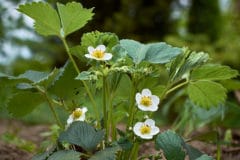Wild Strawberries
Wild strawberries – Fragaria vesca – are known by many names, including wild strawberry, woodland strawberry, Alpine strawberry, Carpathian Strawberry, European strawberry and fraise des bois. The wood strawberry is particularly ancient and mentioned in historical Roman writings. These plants grow wild in Europe, both Americas and northern Africa and Asia, and are also found in gardens.
Strawberry Cultivar Origins
There are a number of different strawberries; today’s commercial and garden strawberries are typically hybrids between one or more of the original species, which include:
- Fragaria bucharica – China
- Fragaria choloensis – Pacific coast of South America
- Fragaria moschata – central Europe, Scandinavia and Russia
- Fragaria nipponica – Japan
- Fragaria nubicola – Himalayas
- Fragaria orientalis – eastern Asia and Siberia
- Fragaria virginiana – North America.
Strawberries in the US
California is, hands down, the largest strawberry-producing state in the US. This state produces well over 90 percent of the annual crop. However, the strawberries available in winter are more likely to have been grown in Florida. Two other states, North Carolina and Oregon, grow strawberries commercially. Still, their production is only a tiny fraction of the annual crop.
Strawberries Around the World
The USA – and primarily California in that country – is the leading commercial strawberry producer in the world. Turkey, Spain and Egypt also produce significant amounts of strawberries. Mexico is another leading producer. Strawberries are also grown in Russia. In the Far East, Japan and South Korea lead in strawberry production. In Europe, Poland and Germany are the top producers.
USDA Zones
Strawberries are widely adapted and can be grown in USDA Zones 3 through 10. However, you must choose the right varieties for your climate. Planting times also vary, from December to February in Zone 10 to the first two or three weeks of May in Zone 3. In colder zones, you will also have to mulch to prevent damage from winter cold.
Growing Conditions
Strawberries will not produce well unless they are grown in full sun. They need fertile soil, which should be prepared well ahead of planting with additions such as aged manure, leaf mold or organic compost. Regular water is required for good crops, but the plants also need good drainage and may do better in raised beds or rows.
Garden Locations
Their perennial nature and growth habit mean that strawberries may be grown in several locations. They do well in containers. Some gardeners use them as a ground-cover, although they will only produce for a few years. You can grow them in a greenhouse or sunroom, or even indoors under lights. They are also grown hydroponically.












